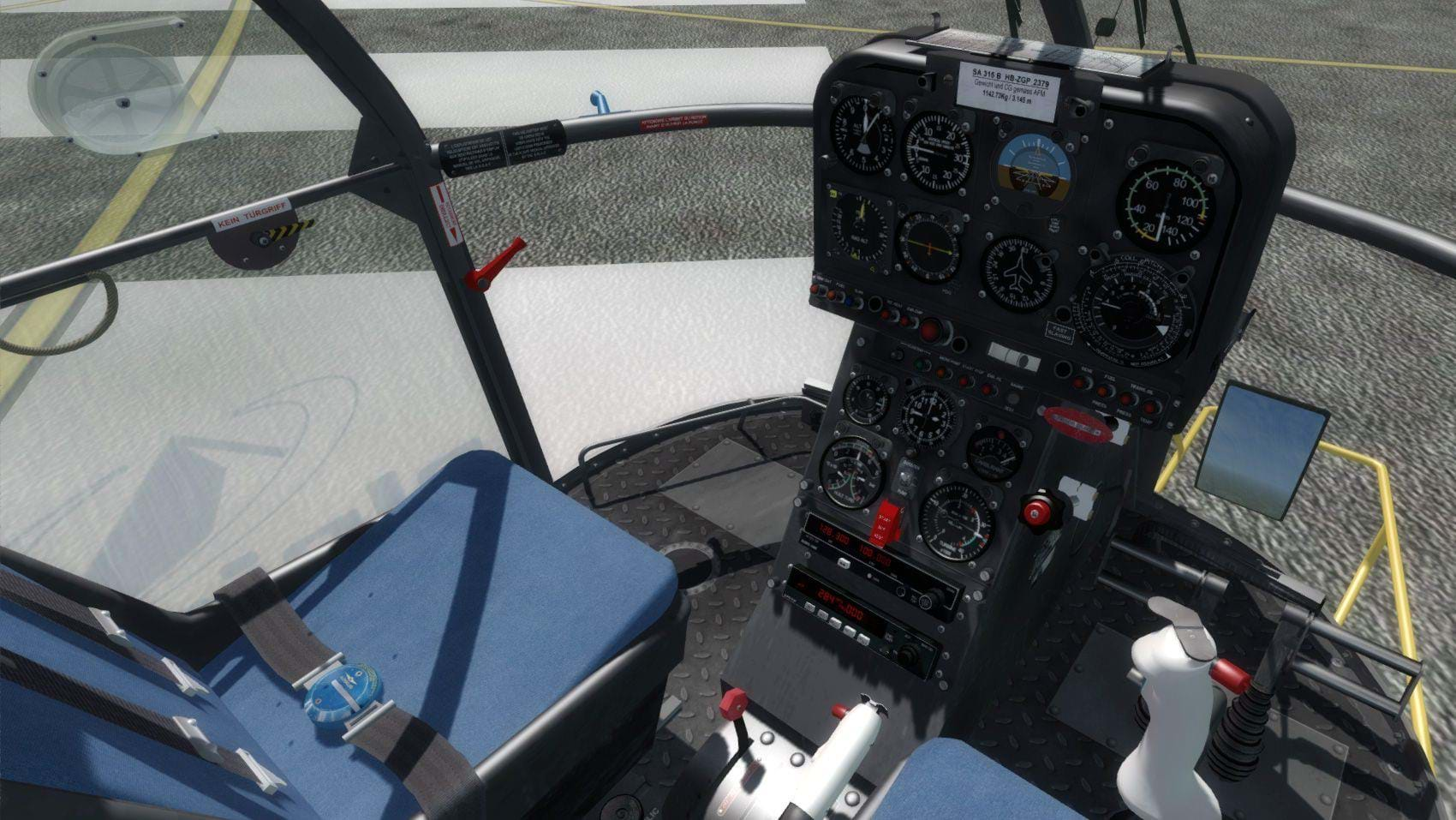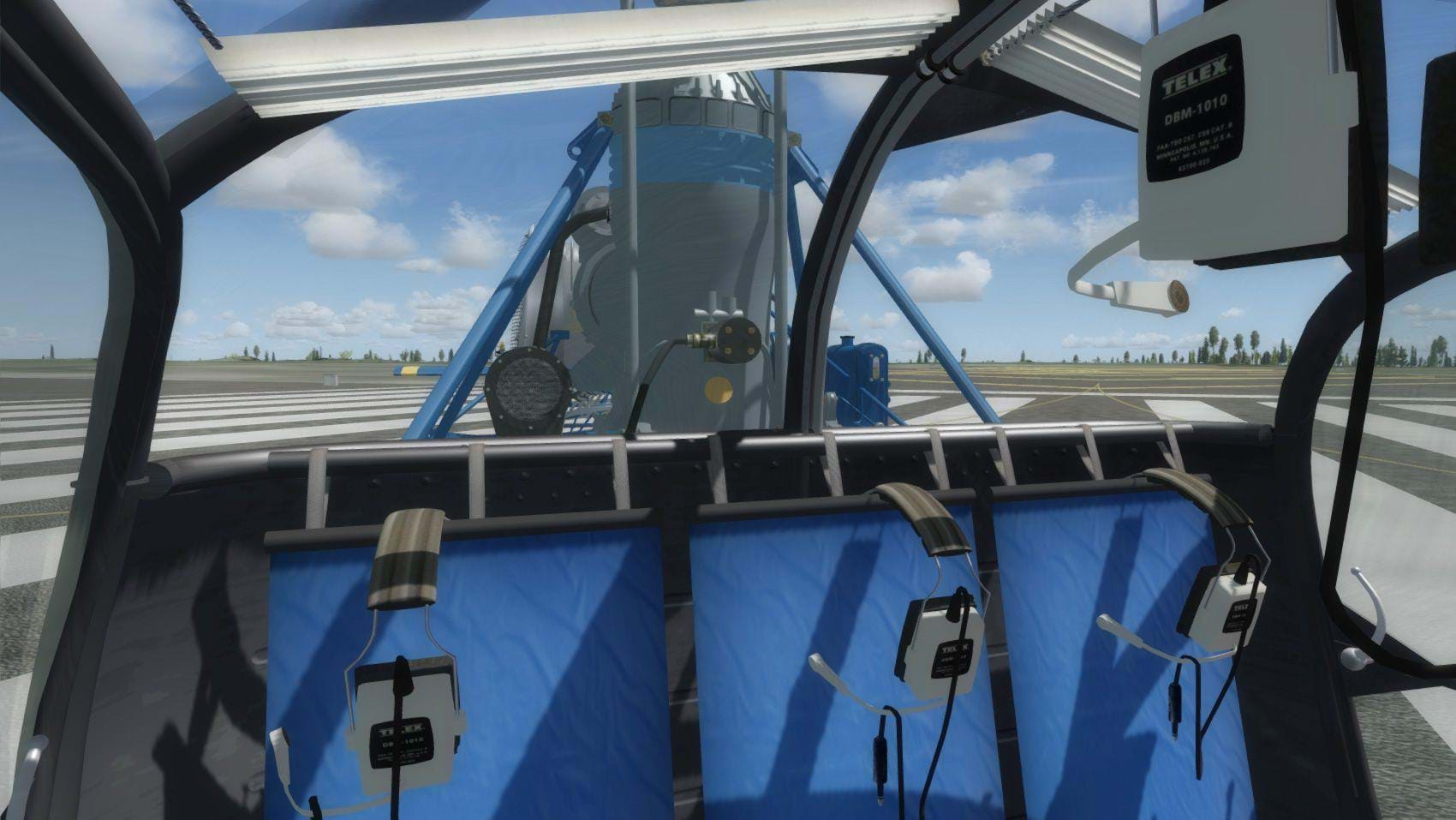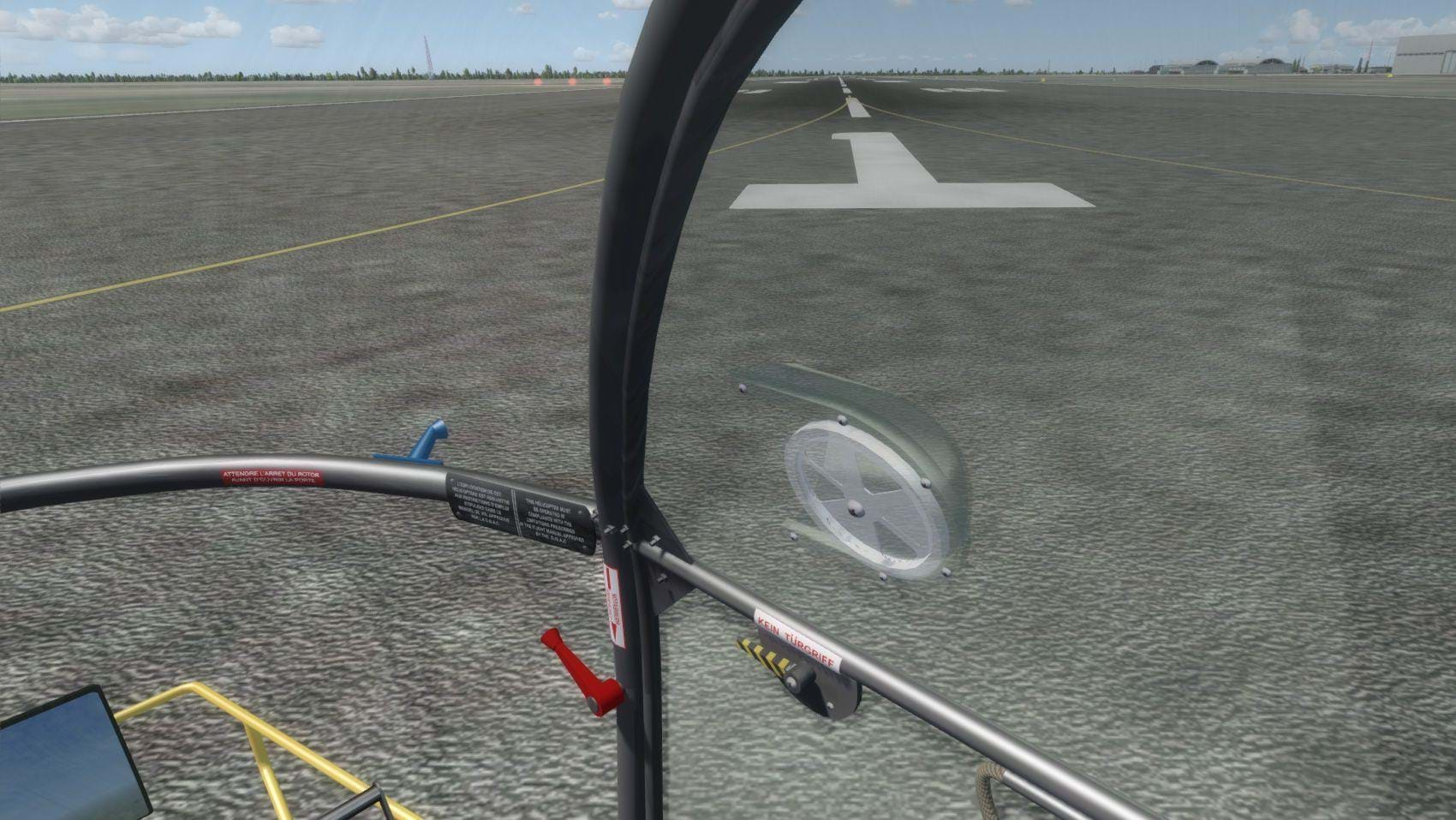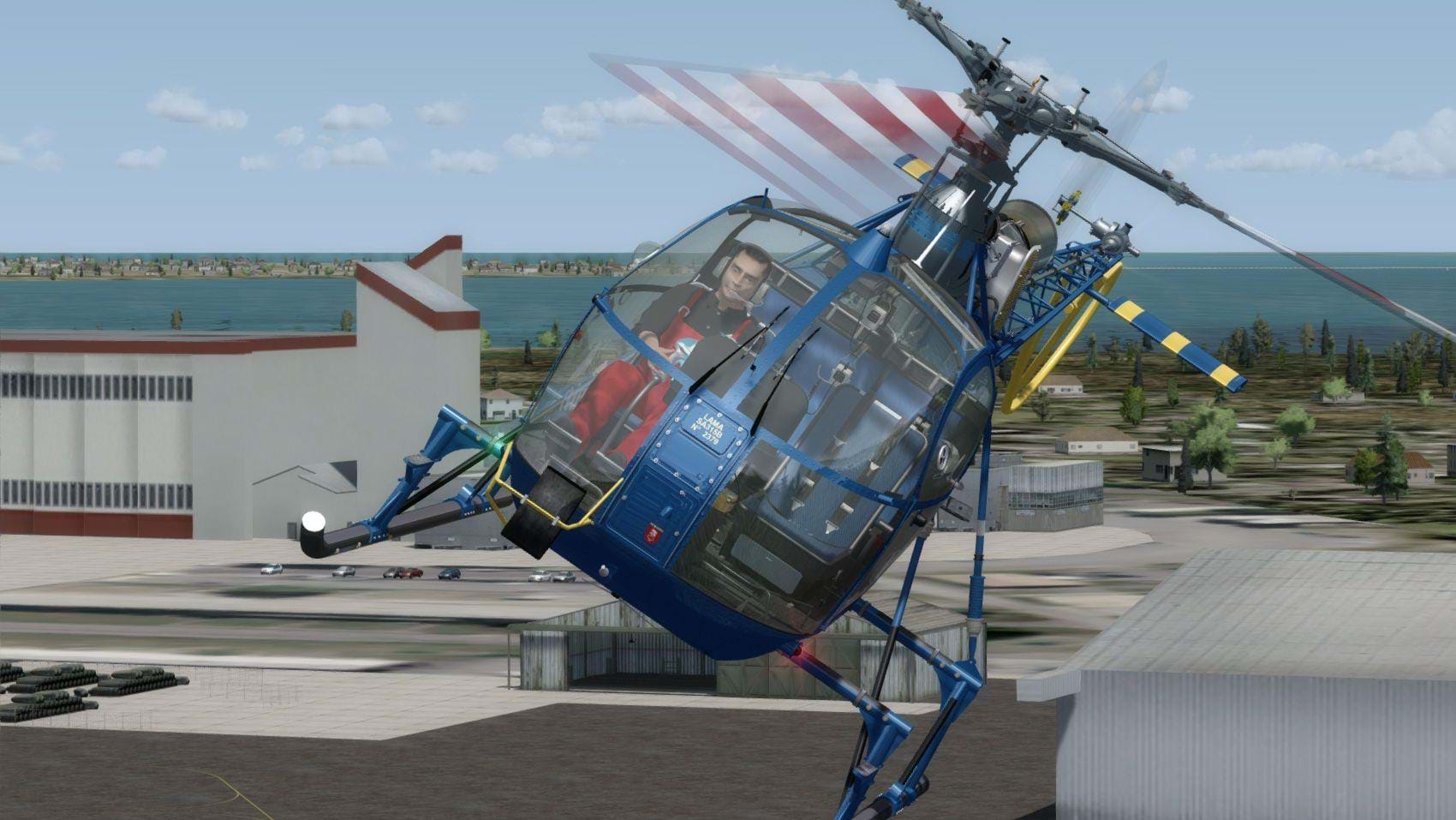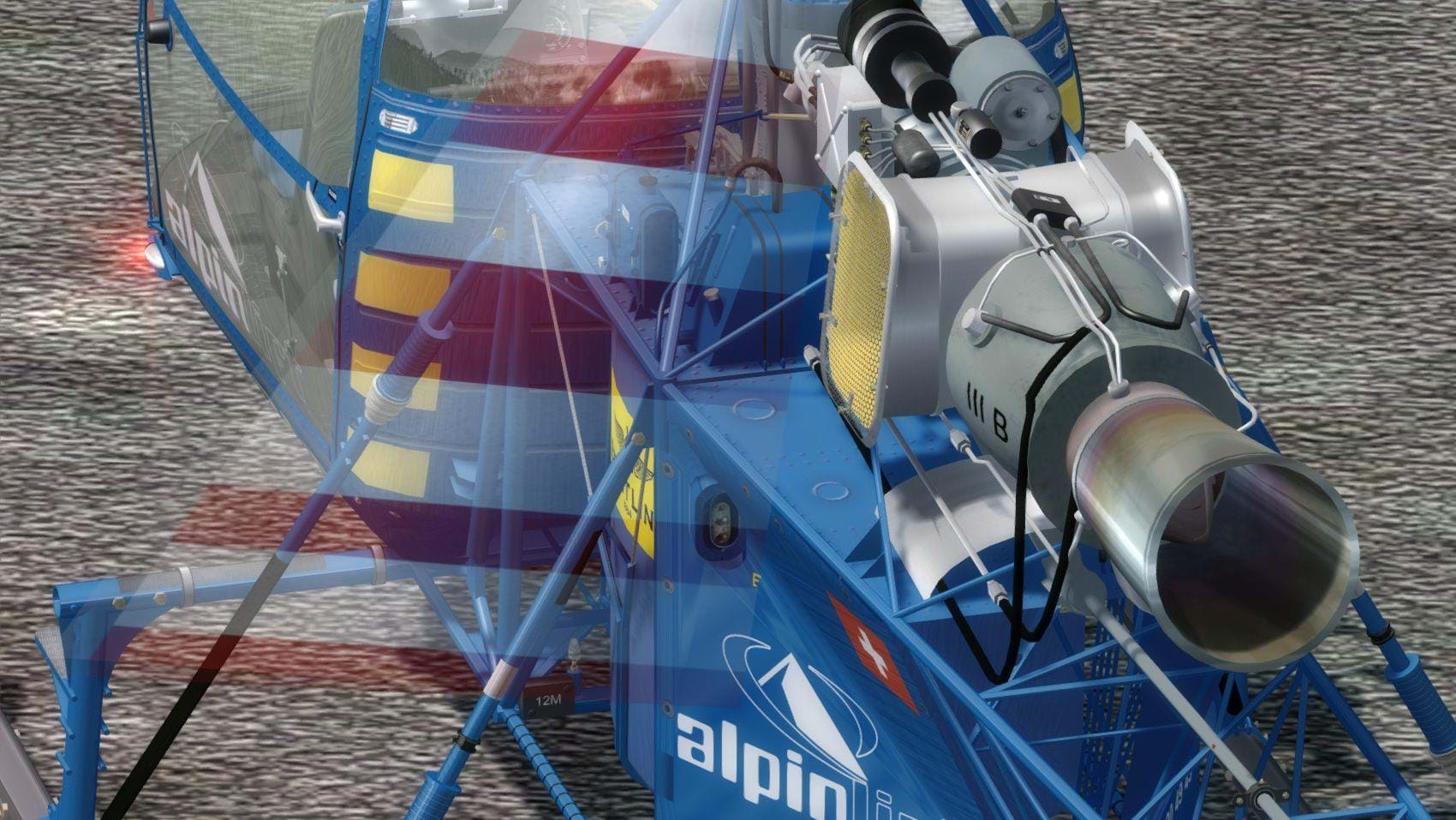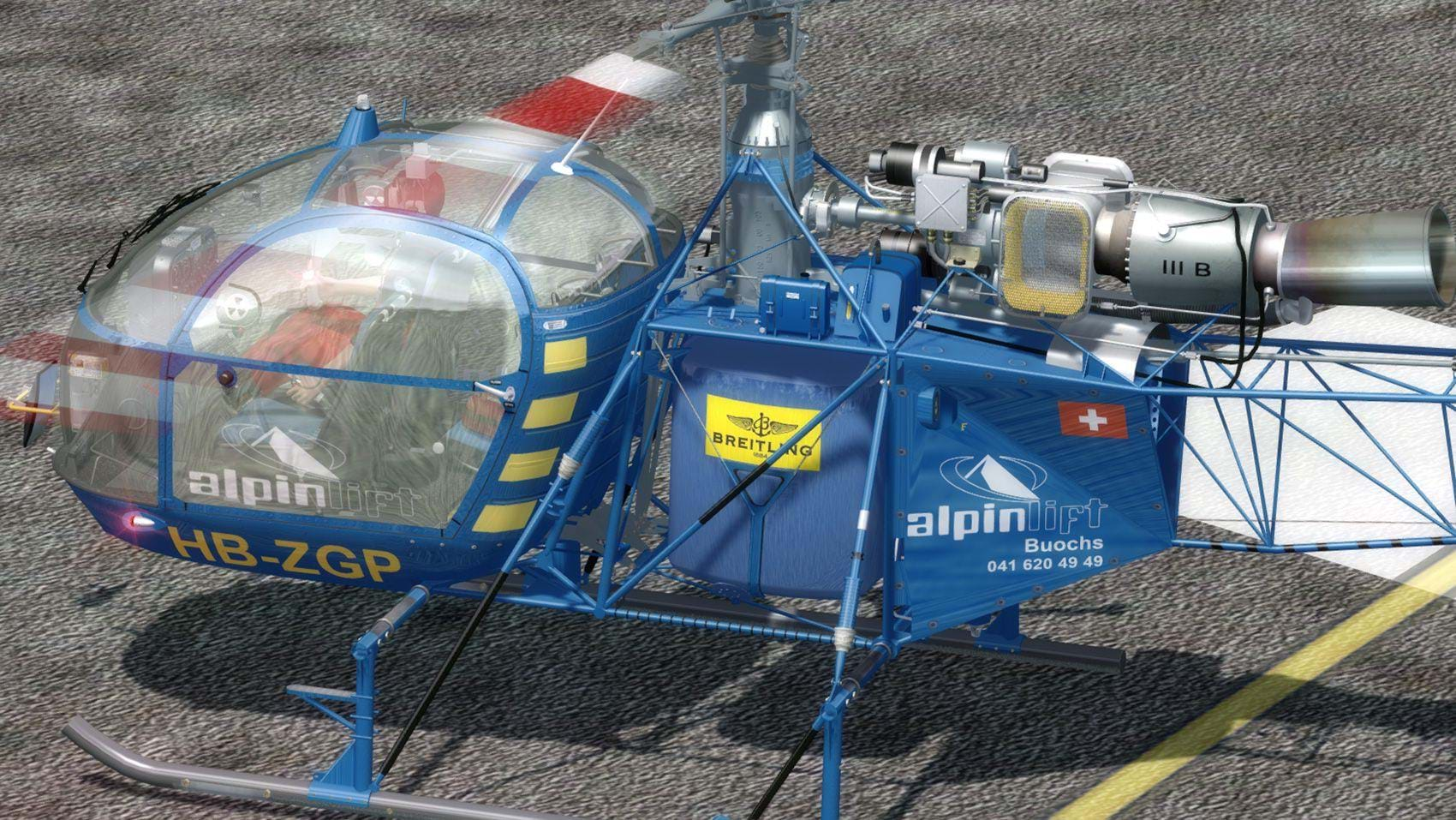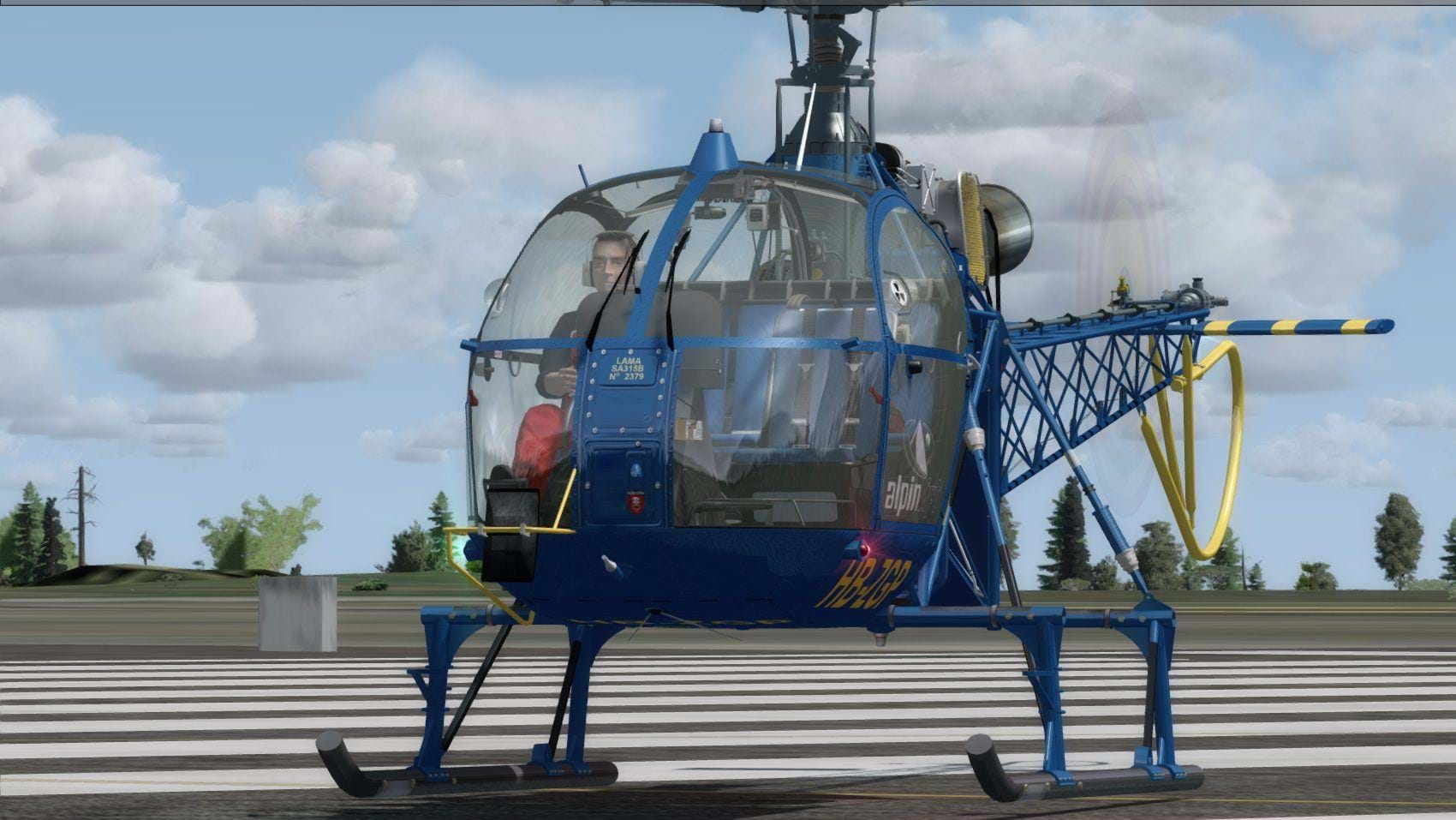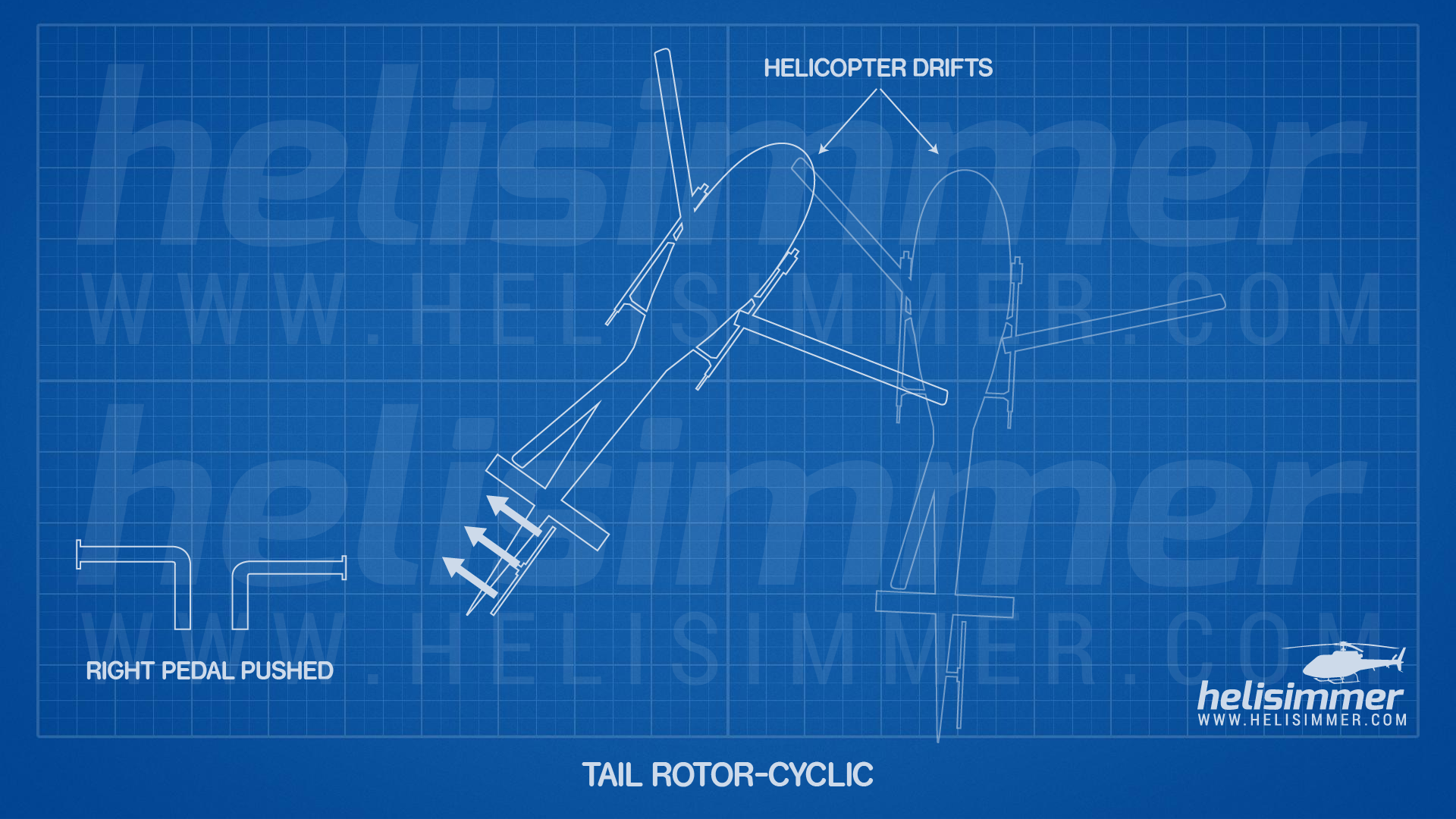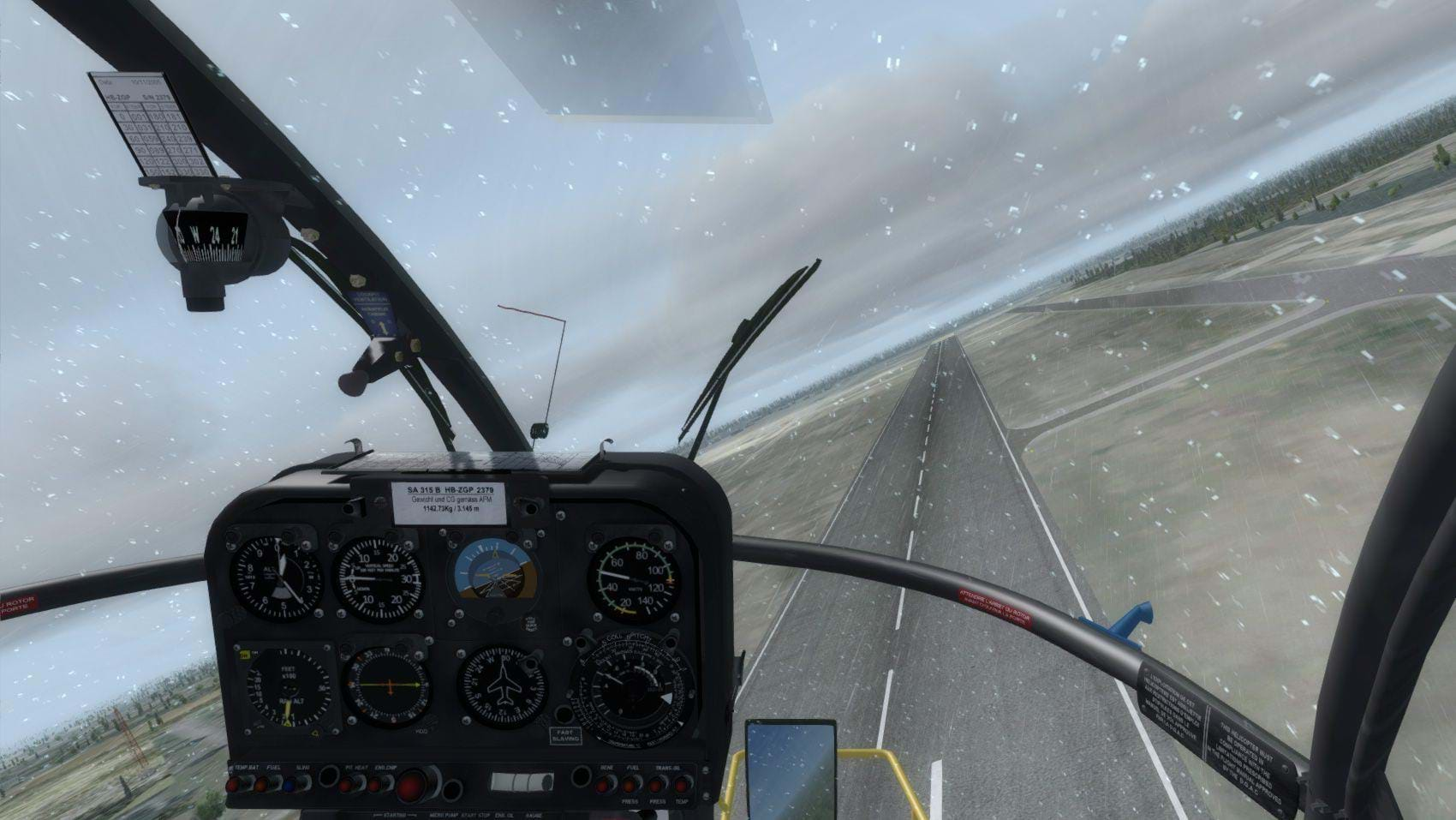The Lama is one of those helicopters that can be considered classics. Just like the Huey or the Bell 47, it’s very recognizable although it can be confused with an Alouette II, sometimes (which is justified since it combines the design of the Alouette II and components and powerplant of the more powerful Alouette III).
It’s a very well-known helicopter in the industry, mostly because of its high-altitude performance. On June 21st,1972, it established a helicopter absolute altitude record of 12,442 m (40,814 ft). When reaching this altitude, the engine flamed out and its pilot, Jean Boulet, performed the longest autorotation in history.
The Lama has a rich and interesting history and it’s not a surprise that a lot of real and virtual pilots would like to put their hands on these machines.
MP Design Studio decided to make it happen for Lockheed’s Prepar3D and they have recently released their model for this sim.
Here’s the list of features, according to the developer:
Developer
- Windshield rain effect
- Wipers washing out rain from the windshield
- Cockpit vibrations
- Instrument panel vibrations
- Engine ventilation
Aerodynamics
- Translating tendency effect
- Transverse flow effect
- Lift effect
- Vortex Ring State
- Retreating Blade Stall
Sound
- Realistic sound environment
- Realistic outdoor and indoor sounds
- Blade flapping sound effect
Model
- Four models available:
- Normal
- Hoist
- Sling
- Spray
- High number of polygons
- Realistic shape and precise geometry
- Fully animated
- Hoist available
Textures
- High-quality textures
- Realistic paint schemes
- Includes all labels and marks
- Include 8 liveries:
- HB-XII
- HB-XMC
- HB-XTM
- HB-XTO
- HB-ZGP
- HB-ZHZ
- OE-EXU
- OE-XJG
Virtual cockpit
- Fully clickable
- Precise geometry
- High-quality textures
- Vibration effect
- Gauges glass reflection
- Fully animated
- All labels and marks
- Rain effect
Equipment
- Bendix King COM KY96A-97A
- Bendix King ADF KR87
Include
- Aérospatiale SA315 Lama Quick Manual
- Aerospatiale SA 315 Lama Flight Manual
- Bendix King ADF KR87 Operating Instructions
- Bendix King COM KY96A-97A Operating Instructions
The model
The Lama is not an extremely complex model shape-wise, although it’s not a simple structure. The amount of tubes and details, which gives it such a distinctive shape, probably makes it a handful to work with.
Modeling is, probably MP Design Studio’s strongest argument and they have done a pretty decent job with all their products. Both inside and out, all their work has been very good. The Lama is not exception and the model is quite convincing.
The only thing that bothered me is how the model doesn’t seem to be sitting on the floor on some angles. The skids seem to be a few centimeters up in the air. It’s not a big deal but it freaked me up a bit when I was appreciating the model from the outside.
Flight dynamics
The old story, right? “How does it fly”? And another old story: “it’s P3D… how DOES it fly?”.
Well, it flies like a P3D helicopter, with some tweaks.
I can’t stop feeling like P3D helicopters feel heavy, clunky. We move the cyclic and they always feel like we are flying through water, not air. I have the same feeling with the Lama. Using other sims (such as X-Plane or DCS), I am used to responsive helicopters and small airframes like the Lama are usually very agile. It’s not true with this one, as it’s not true with any other helicopter in P3D (with the exception of the Dodosim 206 and helicopters that use HTR).
According to MP Design Studio, the model features some interesting aerodynamic behaviors very specific to helicopters. Let’s check them out.
Now, before I move on, please note that I will not go into any major details as how stuff happens. I will try to explain the effects in very simple terms; what we should expect and perhaps provide a short explanation of why, but I will not go into details.
Translating tendency effect
This could be described as the helicopter drifting to the side because of the action of the tail rotor.
What happens is that, because the action of tail rotor causes the helicopter to move sideways (the image below was taken from this article).
What will happen is that you will either be pushed to the side or start compensating using your cyclic. If you look at a helicopter (one that has a tail, rotor, of course) from the front as it’s hovering steadily, you will see that one skid is lower than the other. That’s because the pilot is rolling the helicopter to the side to prevent that drifting.
While testing the Lama, I could not find that effect at all. I placed myself on the runway, took her off the ground and there was nothing pushing me to the side. Being a clockwise-rotation rotor (looking from the top-down) I should be drifting to the left. I could not experience any drifting, any pushing, nothing.
Transverse flow effect
Transverse Flow Effect (or TFE) occurs when the helicopter picks up horizontal speed, at around 10-20kts. The explanation for what happens is a lot more complex but, in a nutshell, at this speed, a portion of the rotor disc generates more lift than the other portion.
For clockwise-rotation rotors, such as the Lama, this causes the helicopter to roll to the left a bit as you pick up speed. It may also happen as you decelerate, but you may not feel it at all.
Now, as you probably know, unfortunately I am not a real pilot. Nonetheless I’ve talked to a few pilots (including Mr. Claude Vuichard, when I visited VR Motion and IPACS) that told me TFE is usually very subtle.
During my tests I did feel the helicopter rolling but I found out some issues with it.
First of all, the roll is very hard, not subtle at all. It’s as if the helicopter was kicked on the fuselage. Or, better yet, as if it had hit an invisible wall. I felt as if it had hit something and then rolled over. During one of my tests I almost lost control of the helicopter since the hit was so hard and, for some reason, I couldn’t do anything with the cyclic for a second or so (I later found out why).
I remember reading that TFE could be felt during deceleration as well, so I paid attention, but I didn’t feel a thing. It’s not necessarily a bad thing as, again, I was told you can barely, or not feel it at all, but I had to keep on getting the effect during acceleration. So, I just ignored the deceleration part.
I kept on testing it and I found a curious effect. If I gained speed quickly, the helicopter would roll a bit violently to the left but then recover and move on. If I gained speed slowly, it would roll, gain altitude and I lost control of the helicopter.
Because of the behavior I was getting from it, I ended up with the theory that MP Design Studio is probably simulating the effect by removing or reducing the control of the pilot at a certain speed and rolling the helicopter abruptly, but that’s adding a set of side effects.
By gaining speed slowly I was rolling even more violently, losing control of the helicopter and gaining altitude. Remember me saying that it felt like I was hitting something? It’s as if I was hitting a slope that not only rolled me but pushed me up. And, if I kept the speed at around 15kts, I lost most of my cyclic control. In fact, not even the cyclic moves in the cockpit.
For low-speed maneuvers (anything below 20 knots) this makes controlling the helicopter very, very tricky or near to impossible. I actually crashed during one of the tests and the helicopter rolled very violently, gained altitude but put me nearly upside down.
Funny enough, accelerating too fast is also not a good thing. I tried to pick up speed quickly and the helicopter tended to pitch up, then down violently and I eventually crashed.
Lift effect
I have no idea what is it that the team calls “Lift effect”, so I can’t comment on it.
Vortex Ring State
Things get tricky here, once again.
You can find a bit more of information about VRS in our article here but, in a nutshell, Vortex Ring State (which, guys, is NOT the holy grail of helicopter sims – you need a lot more than VRS present to say a sim is realistic) happens when you descend into the downwash/vortices created by your rotor and you lose lift.
It’s a very dangerous situation in which, if you don’t take proper action, you can crash into the ground.
Usually, to get out of VRS, you will need to pull the collective down (yes, down – I know you are falling from the sky but, trust me and read the above article about VRS) and move your cyclic to any direction (usually front) so that you get out of the turbulent air.
Here’s the thing: remember me just saying that MP Design Studio cheated (or hacked) the Lama so that it would emulate the nudging of transverse flow effect? And that they did it by removing control of the cyclic while they provided some lateral movement (along with some other weird movement that feels like we are hitting something)?
Well that lack of control is really not handy when you are in VRS and trying to get out of it. I quickly lost control a few times because of it and ended up crashing. I pulled off from VRS a few times but it’s not an easy task as the helicopter takes away your control. It’s doable, but you will need to be careful.
Again, I feel like the team had to cut some corners and hack the effect into the sim, just like with their previous helicopters. It seems like they are simulating VRS by limiting the action of the collective. If you look at the torque needle and try to increase collective, you’ll notice the needle wants to go up, but it then goes down fast, to a position where you lose altitude.
It’s a smart way of doing it, yes, and with proper care you can practice coming out of it, but, just like TFE, it’s still not actual VRS. If you are a real pilot or know how a helicopter should behave in these conditions, you’ll have to take it with a pinch of salt. The team is working with what they have so they need to be creative.
Retreating Blade Stall
Another one of the crazy aerodynamic effects, retreating blade stall happens at high speed when the blade that is moving “backwards” (to the back of the helicopter) stalls (loses lift). When this happens, the helicopter rolls to that side. For the Lama, this should happen on the right blade.
During my tests, the Lama entered this state at around 120kts. When hitting this speed, I kind of felt the same as with TFE but on the opposite side: a sudden jink, more than a fluid movement.
And, again, as it happened, I lost control of the cyclic. While not as bad as losing control at lower speeds (since the helicopter is more stable, cruising gladly through the skies) it still freaked me out a bit. Not because of the roll but because I lost my cyclic.
As with the TFE, the nose also raised, as if I had hit something. Again, not something you expect to happen, and not very pleasant for the user.
Other notes
One of the things I immediately noticed is that the Lama needs no pedal whatsoever. I could do a whole flight without touching the pedals. Not even on takeoff I needed any pedal input. I tried the default R22 and switched between it and the Lama a few times to make sure it wasn’t a hardware or configuration problem.
It wasn’t. The R-22 needed pedal, the Lama didn’t. That came out as a surprise.
Equipment
The Lama comes equipped with a couple of custom pieces of equipment: the Bendix/King COM KY96A-97A radio and the Bendix/King ADF KR87 ADF receiver.
You’ll find a couple of manuals on the documentation folder which describes how the units work. These are not very complex radios and you’ll get up to speed fast enough. There’s not a lot to say about them. They work fine, and I believe I had used the ADS receiver before on some other addon as it’s developed by FSD. If you have used on another aircraft it before, you’ll find it familiar, of course.
Effects
Rain and wipers
MP Design Studio added a “rain” effect to the cockpit where, whenever it’s raining, you can see drops on the windshield.
These drops are not dynamic (they don’t move around as the helicopter moves) but they are rather static. The team seems to be using a few textures that provide some more realistic behavior of drops appearing and disappearing which I found to be really cool and smart. The fact that they are using some simple textures also make it light on frames, so you won’t have any issues with this addition.
The way they simulate the wiper cleaning up the windshield is also smart, and it seems like they are replacing a portion of the windshield texture (or the whole texture) with one clear at the place the windshield passes on. It’s simple, effective and adds up to the immersion of the sim, while keeping it all FPS-friendly.
Panel vibration
This one freaked me up! In a good way, that is.
I had no idea the internal part of the panel is made to shake, instead of the whole panel. So, when you enter the cockpit for the first time, you might be surprised to see it moving while the outside stays quiet.
I could not find any conditions in which the panel vibrates more or less (it seems to be always the same to me) but, in reality, it doesn’t matter. It’s good enough to provide a bit more of immersion and realism and, again, a welcome addition.
Freaky, but I love it!
Sound
Sound quality is as expected from the team. They always do a good job, but I think some volumes could be tweaked. Blade slap is present as announced but a bit too on the low side of the volume bar.
I found something weird, though. I shut down the engine and the sound kept on going. Not the shutdown sound but the normal engine sound as if it was running at 100%. It’s definitely a major bug that MP should look into.
Extras
Cool freebie! MP Design Studio has a Scenery Pack available for download, for free (not only for the owners of the Lama but it has been released as a Lama Scenery Pack. You can find (and download) it here.
This gives you a few places to fly at and improve your experience with the model. If you’re looking for a few hours of fun, these places should do the trick!
ICAO code for Helicopter Pack:
- Collombey-AGCM
- Gampel-AZGA
- Gsteigwiler-LSXG
- Heliport Archamps-LFXD
- Heliport Zweisimmen-LSXZ
- Leysin-LSXY
- Schattenhalb-LSXC
ICAO code for Sling Operations Scenery
- STA1 to STA9
Virtual Reality
Of course, I had to try it with VR. The Lama is not a huge helicopter, but the all-glass cockpit gives you a sensation of freedom that you won’t find on other helicopters. Just like it’s older sisters, the Alouettes II and III, the outside visibility is superb, and, in VR, it just shines.
The cockpit is a pleasure to look around at and the whole visual experience is very, very nice.
It’s one of those helicopters that look like they were meant to be flown in VR.
Conclusion
The MP Design Studio SA315 Lama is a nice helicopter for P3D. It’s not brilliant, it doesn’t bring anything that will raise any eyebrows but it’s fun to fly around with.
My main complaint is that the attempt on modeling Transverse Flow Effect actually hurts the handling of the helicopter as you need to be very careful at low speeds. Around 15-20 knots you can lose control very quickly, so you will need to be careful.
I could finally experience some of the stuff MP Design Studio has been announcing on their helicopters (unfortunately, I couldn’t make it work on the other helicopters – I tried the Cabri G2 again while testing this one and I still have the same issues as before) but the experience is somewhat weird.
The sound issue on engine shutdown also left me a bitter taste on my mouth. It’s nothing I’d expect to find in a product by a team that’s been around for quite some time already and one that I hope they’ll fix soon.
I welcome their effort, but I wonder if it’s worth add features to a helicopter, that make it behave weirdly, just for the sake of saying they are present. I’d rather have them not add these characteristics and just accept the shortcomings of the sim. Milviz, CeraSim and Nemeth Designs all do it and people simply accept the fact that, if they are flying their favorite helicopters in P3D, they are making a trade-off.
I have been very vocal as to try and bring MP Design Studio to other sims that could probably allow them to get better results (such as X-Plane). They would not need to give up on P3D, but they could cater both markets and perhaps do an excellent job on both – knowing and accepting the shortcomings of the platforms.
For P3D, they could probably release their products with a good HTR profile. If users wanted a regular FSX/P3D helicopter, they would have it without bells and whistles. If they wanted it more realistic, they could go with HTR.

